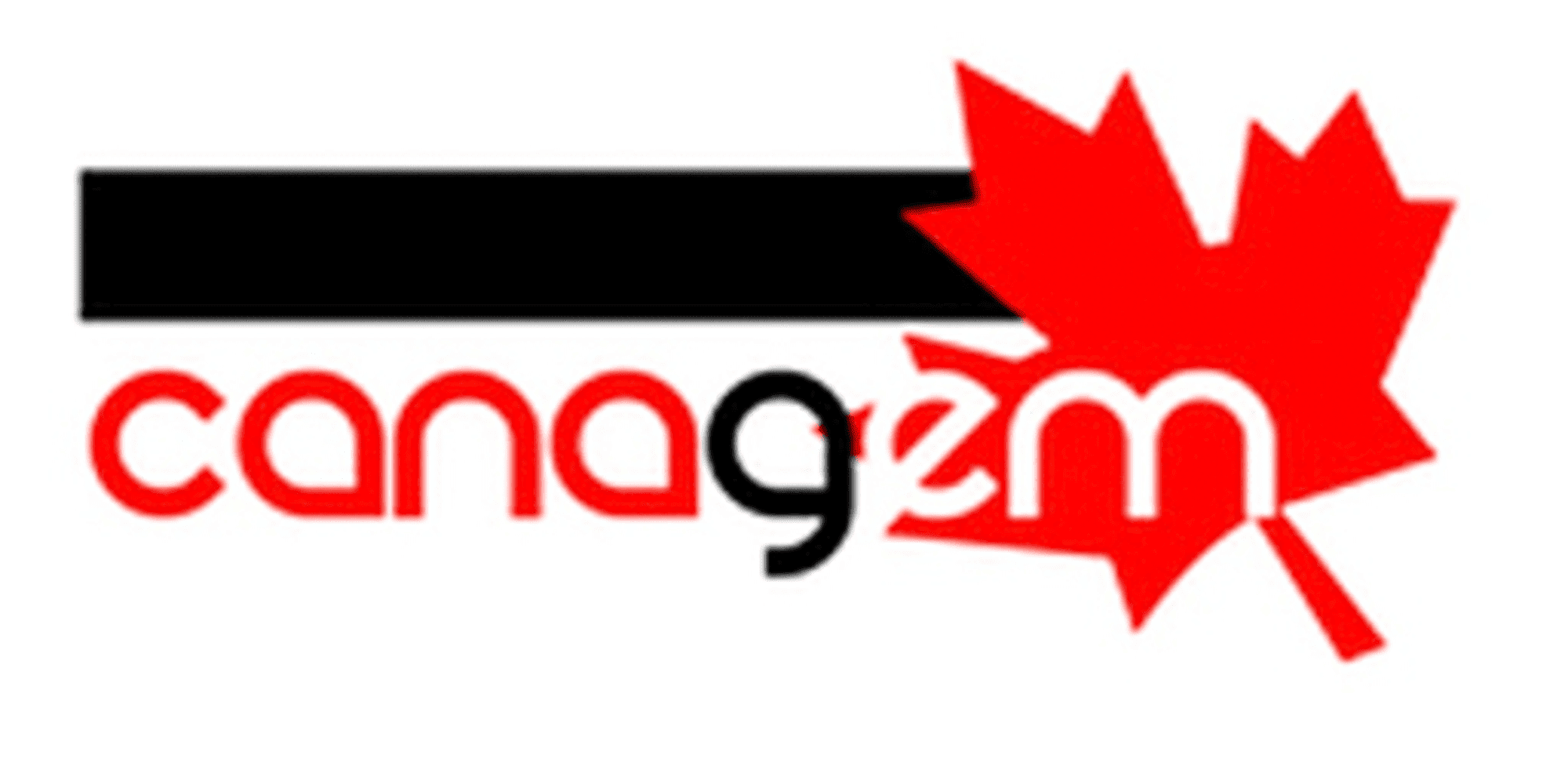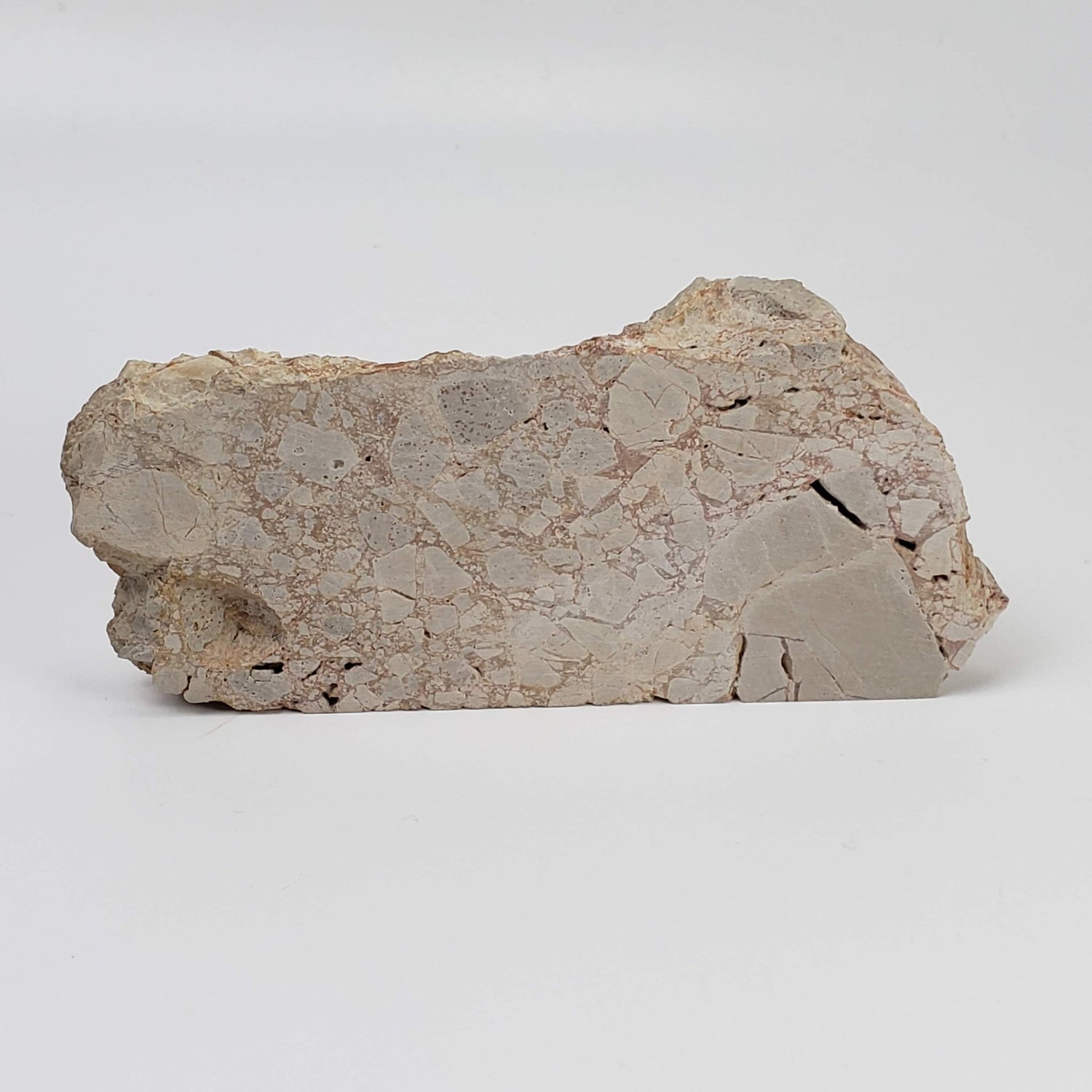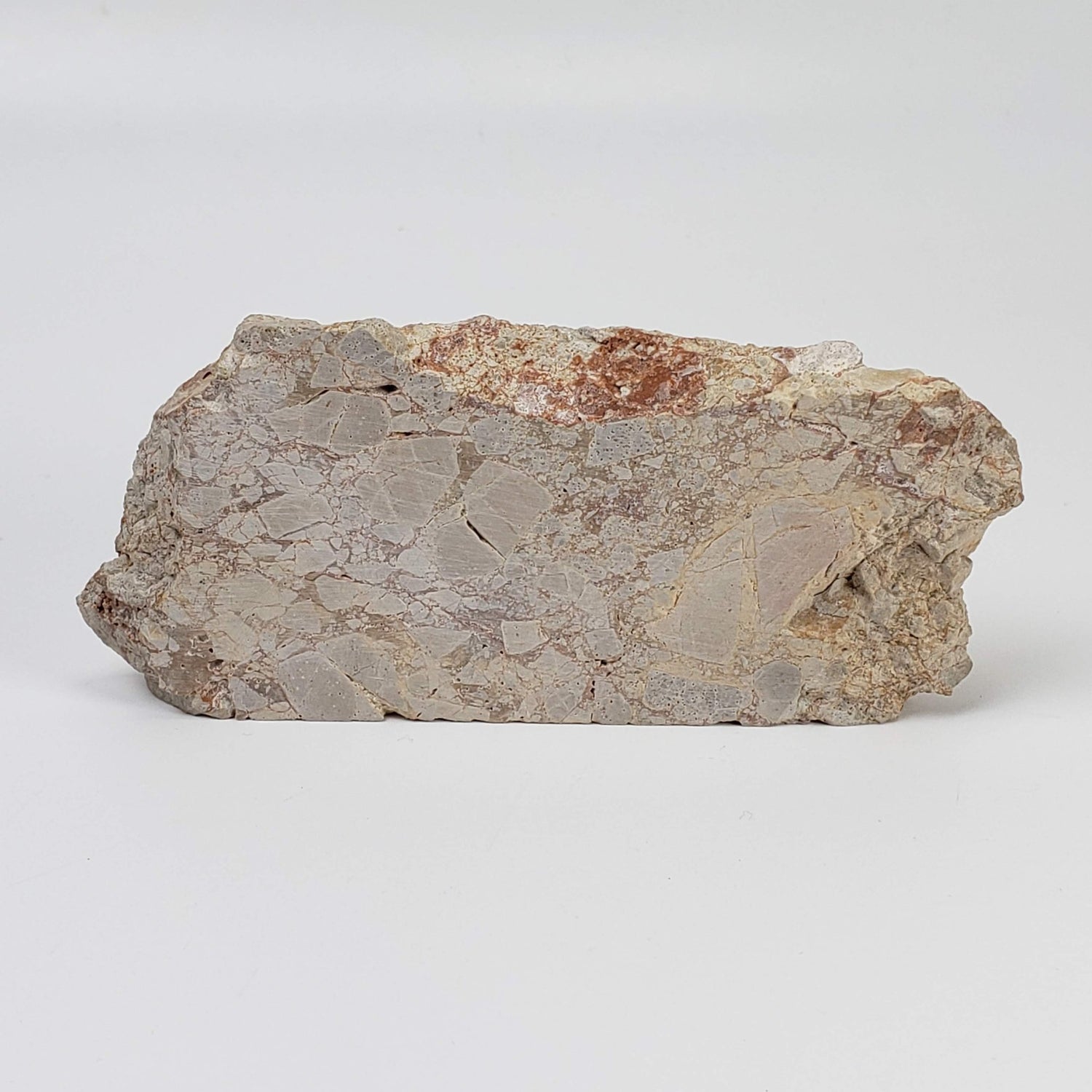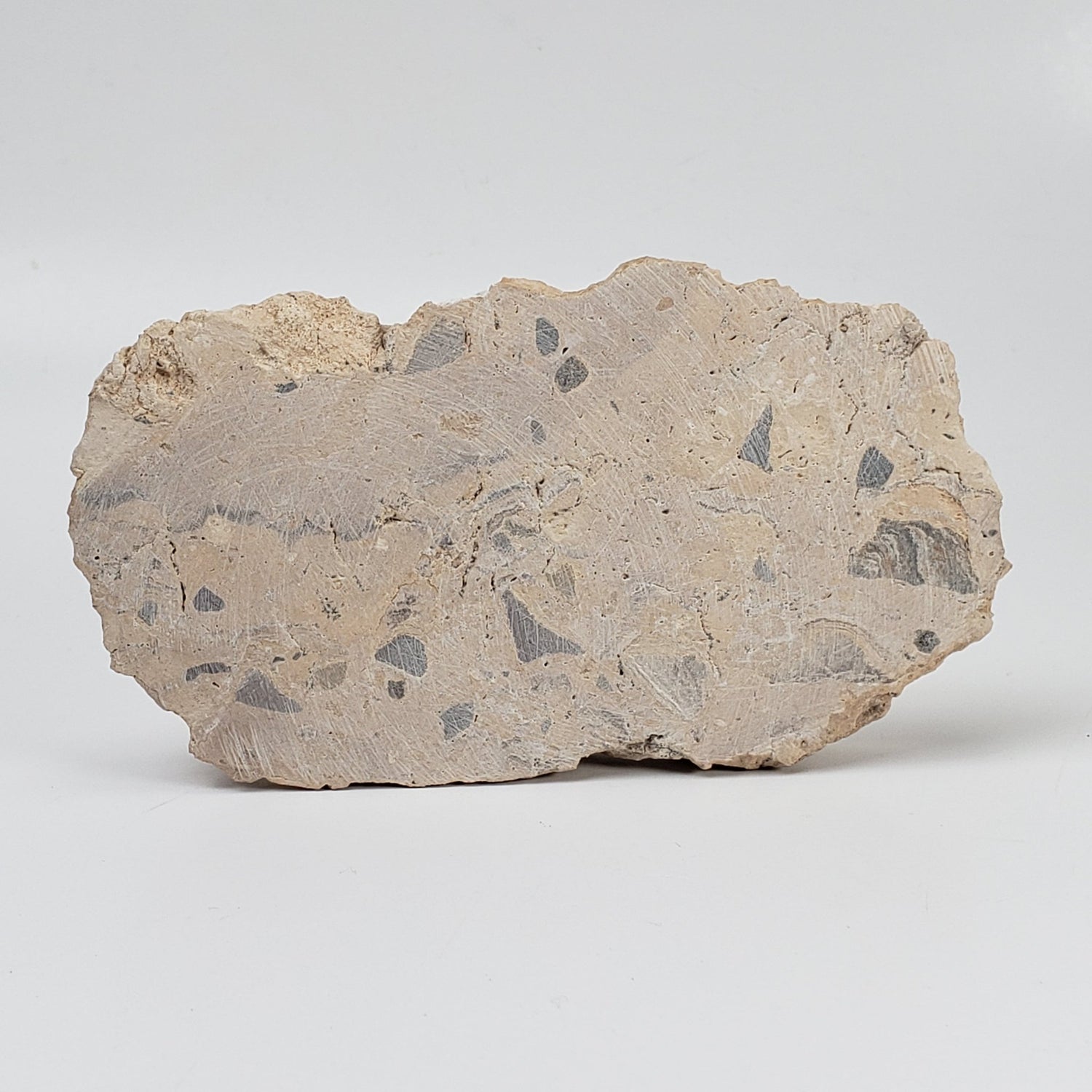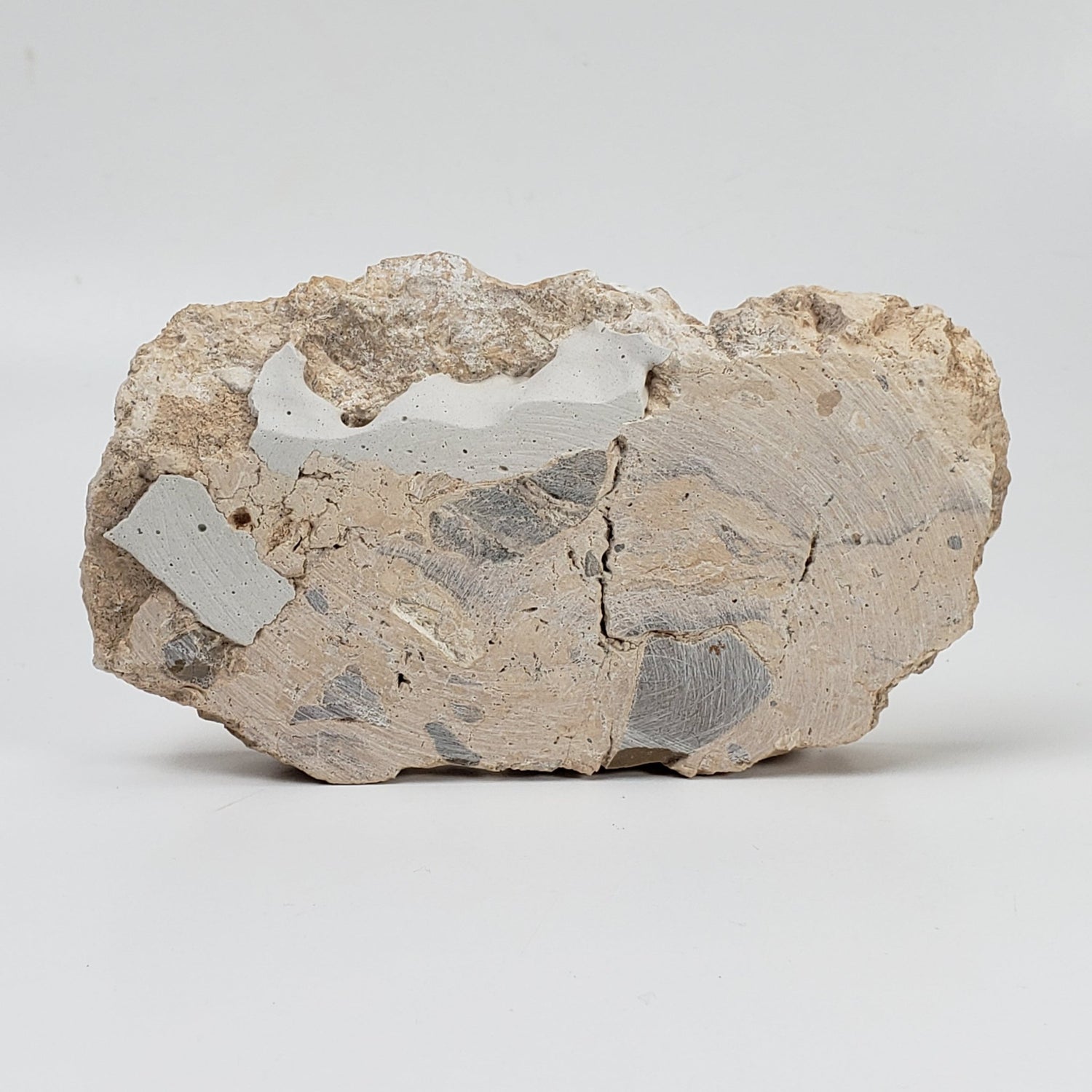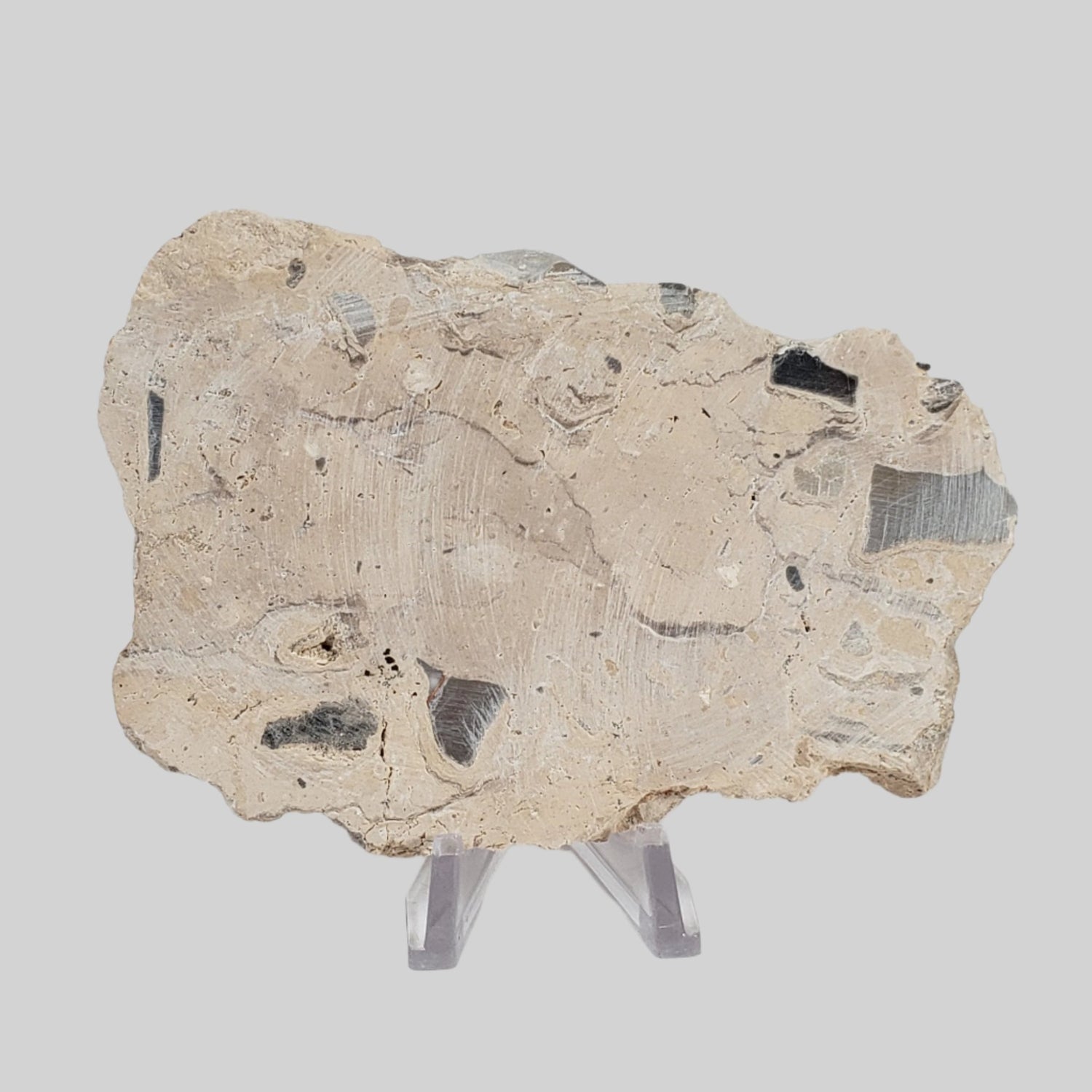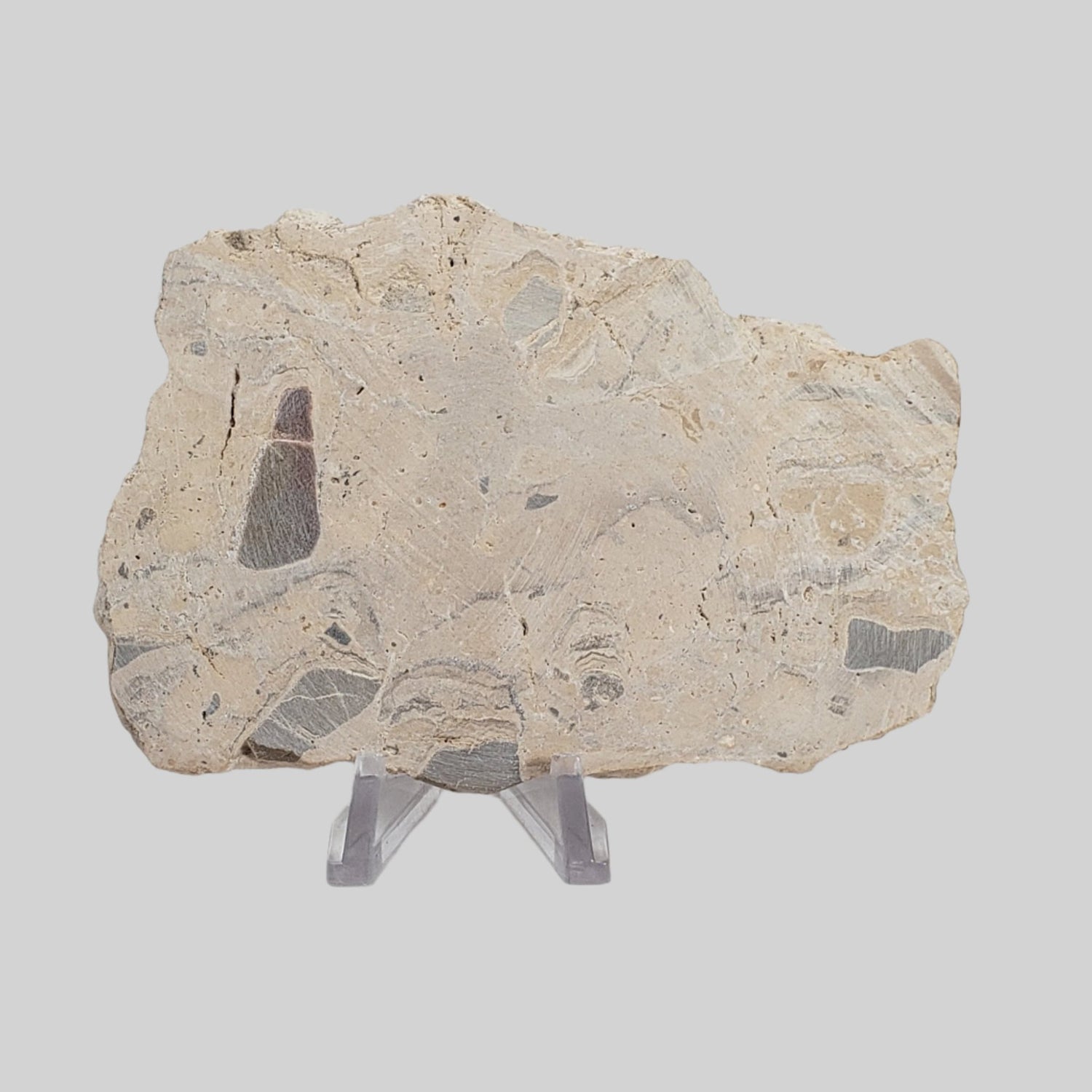Sort by:
18 of 109 products
18 of 109 products
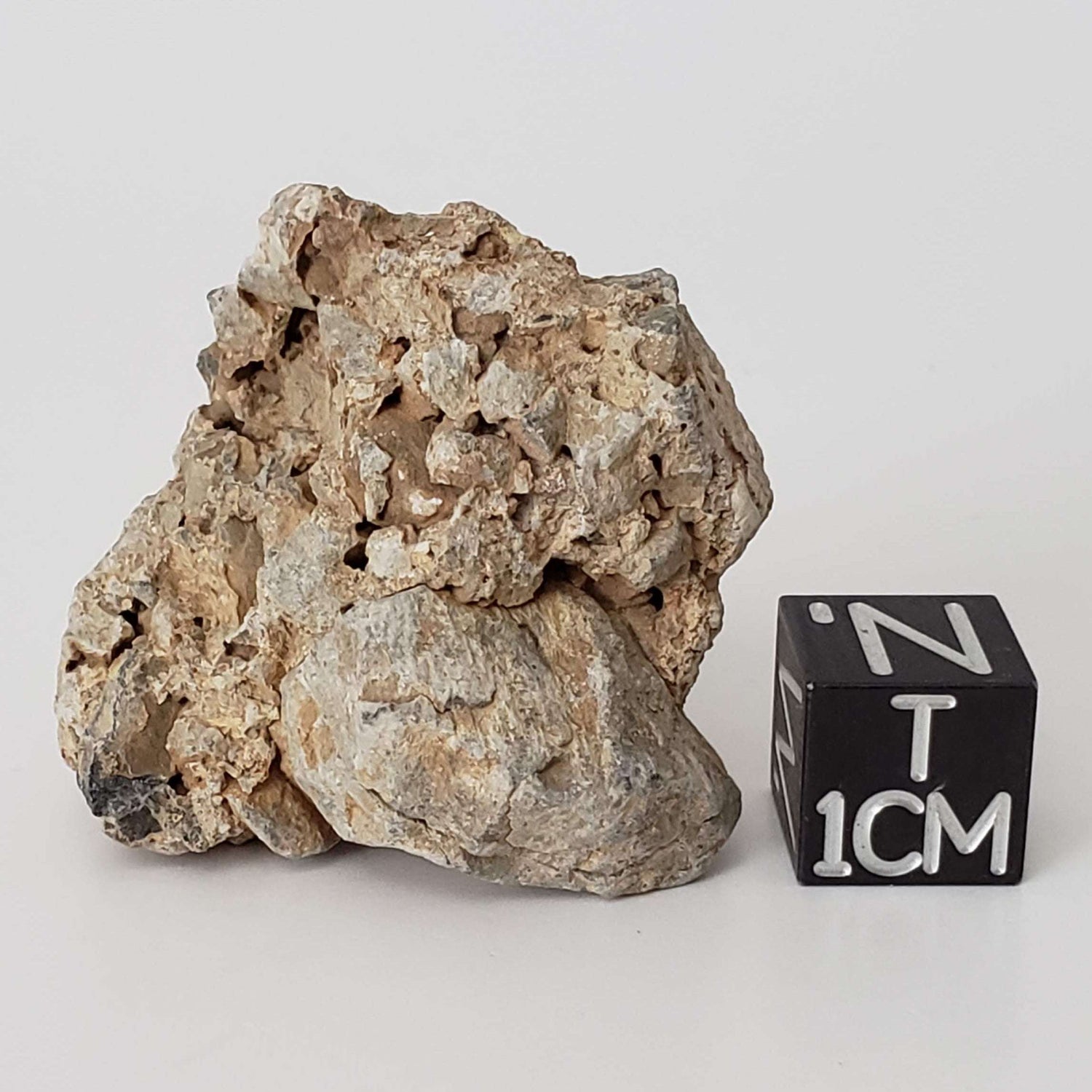


Impactite Monomict Breccia | 16.8 grams | Agoudal, Imilchil Structure | Morocco
$27.00 CAD
Unit price perImpactite Monomict Breccia | 16.8 grams | Agoudal, Imilchil Structure | Morocco
$27.00 CAD
Unit price perThis is a must have 16.8 gram Impactite, monomict impact breccia from the Agoudal, Imilchil impact structure, Morocco. Although not a meteorite, impactites are directly linked to them and their impacts and are probably going to be one of the rarest collection items you'll ever own. Impactite is a slag-like glassy object found on the surface of the earth, formed from rock melted by the impact of a meteorite.
The term impactite encompasses shock-metamorphosed target rocks, melts or suevites and mixtures of the two, as well as sedimentary rocks with significant impact-derived components and shocked mineral grains, tektites, anomalous geochemical signatures, etc. According to the state of conservation of the meteorite into the sedimentary layers "Soltanian" and the dating of ancient lake sediments of the Isli lake, we can estimate their age limit to 40,000 years.
More than 183 structures of meteoritical impacts are highlighted on the Earth, including only three reported dual impact craters. The impact craters of Isli and Tislit are respectively located at 10 km and 4 km from the Imilchil village on the Central High Atlas in Morocco at respective altitudes of 2272 and 2266 meters. They are spaced apart from each other by 9.4 km. The origin and the date of formation of these two lakes are still unknown today. Surveys undertaken near them and in the surrounding areas leads to believe that they correspond to a dual meteoritical impact crater.
Polymict and monomict breccias were observed at the edges of these craters but they don’t form big masses because of erosion. They consist of irregular fragments with millimeter and centimeter sizes, in a carbonate matrix. In the breccias collected on the southern edges of the Isli crater, we noted the presence of several shocked quartz grains in planar structures associated with rolling extinction, indicators of shock metamorphism.
This gorgeous specimen displays very well with a mass of 35x35x25 mm. Would be a beautiful addition to any new or existing collection. Comes with a Canagem Collection specimen card.
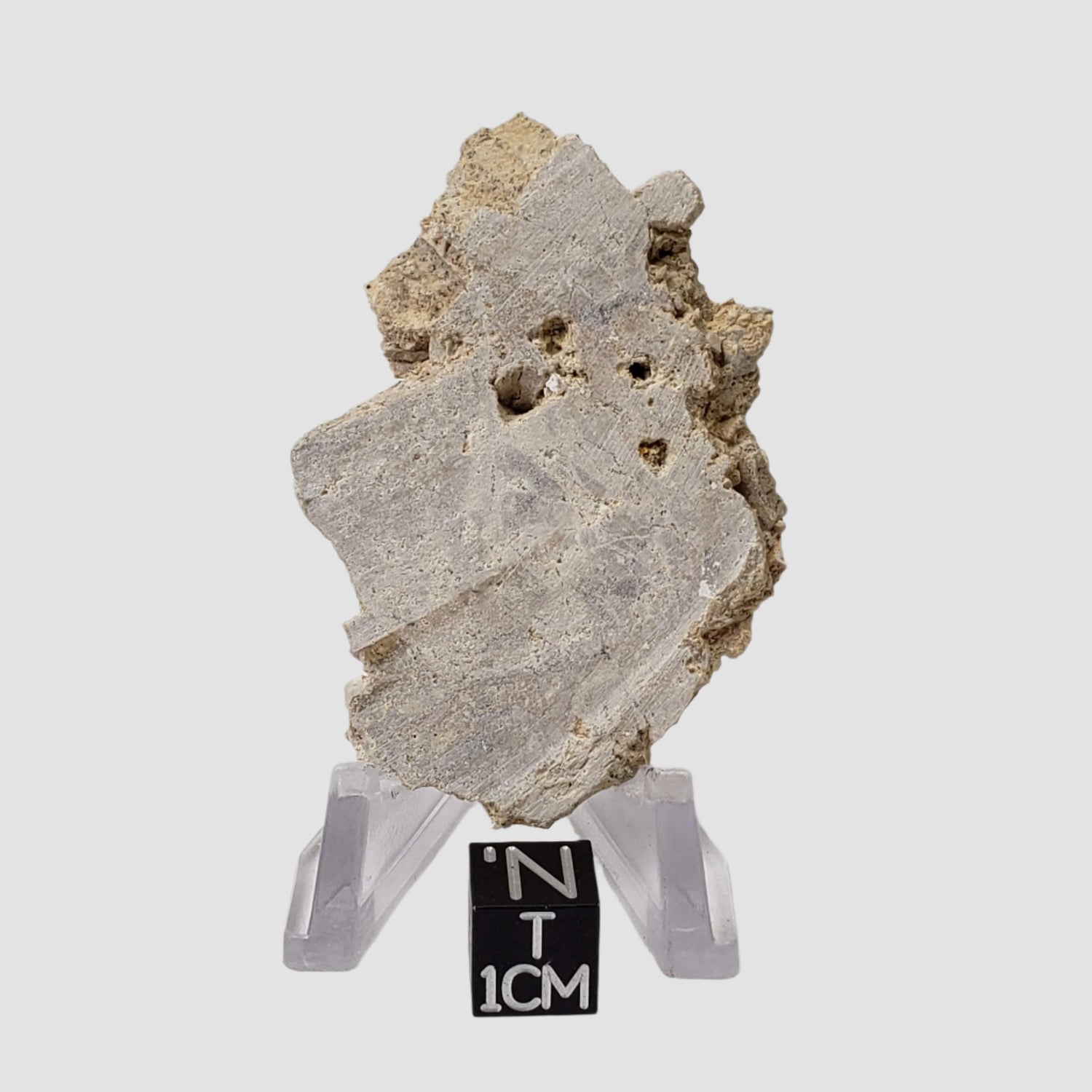

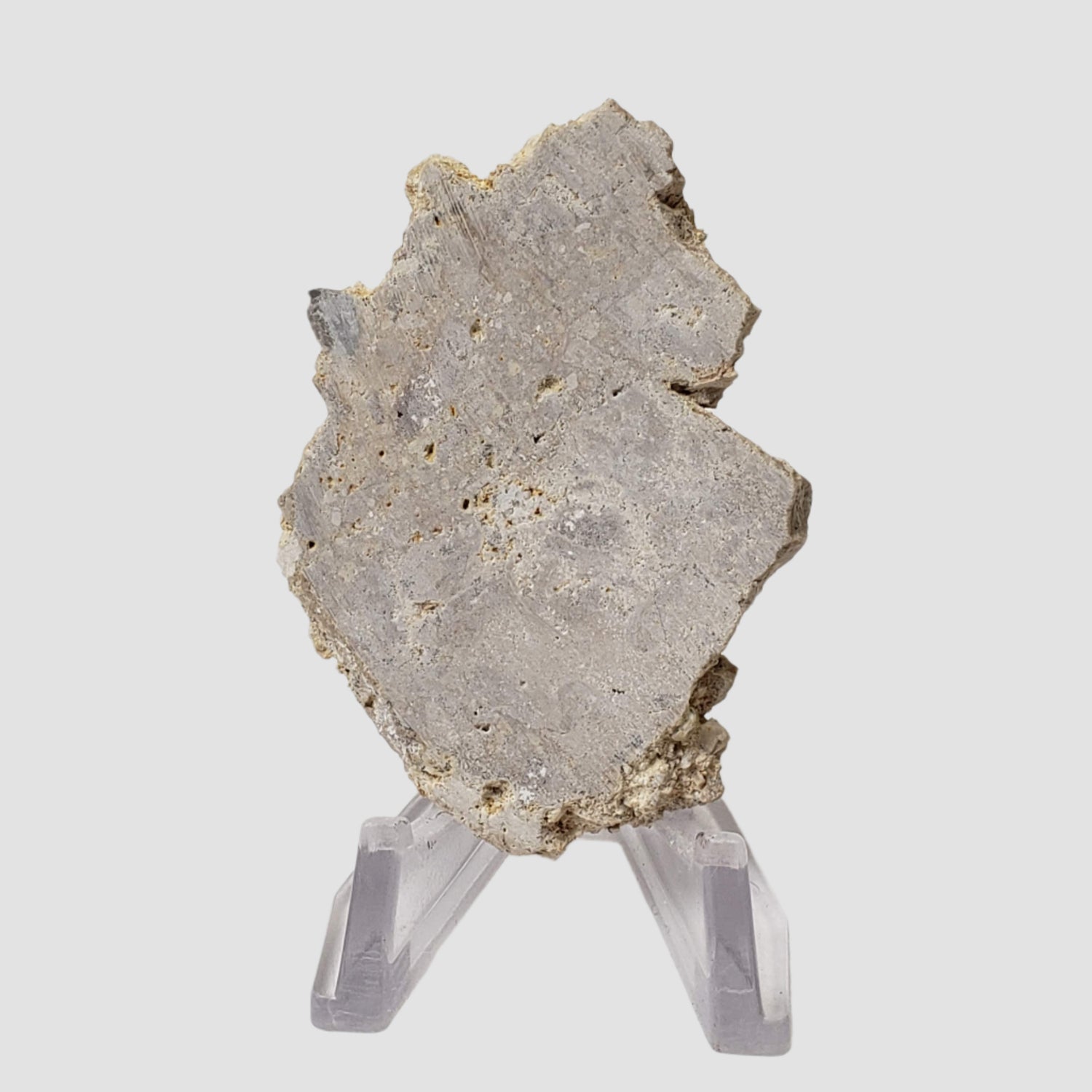
Impactite Fallback Breccia | Steinheim Basin Impact Structure | 21.3 grams | Slice | Ries, Germany
$14.00 CAD
Unit price perImpactite Fallback Breccia | Steinheim Basin Impact Structure | 21.3 grams | Slice | Ries, Germany
$14.00 CAD
Unit price perThis is a fantastic Impactite Fallback Breccia from Germany weighing 21.3 grams and measuring 60x41x6mm. Although not a meteorite, impactites and shatter cones are directly linked to them and their impacts. The Steinheim Basin today exhibits a distinct morphological depression that is ∼110 m deep and ∼3.5 km in diameter; the height of the central uplift totals to more than 140 m. The original size of the pristine crater is estimated to be ∼3.8 km with an original depth of ∼205 m.
As this drainless morphological depression was filled by lake sediments shortly after the impact, the primary crater morphology is widely preserved. The crater rim is formed by steeply inclined and intensely brecciated Upper Jurassic limestone blocks that also contain numerous shattered chert nodules, as well as some loose blocks of the host limestone. An impact breccia, referred to as the so-called ”Primäre Beckenbrekzie” (“primary basin breccia”) and interpreted as a “fallback breccia”, is known from many drillings in the Steinheim Basin.
Mainly composed of Middle to Upper Jurassic limestones, marls, mudstones, and sandstones, the impact breccia inside the morphological depression of the Steinheim Basin is overlain by lake sediments and is obviously preserved in its original thickness and position. This piece displays very well and is a very nice size showing multiple characteristics of its origin. Would make a beautiful addition to any collection.
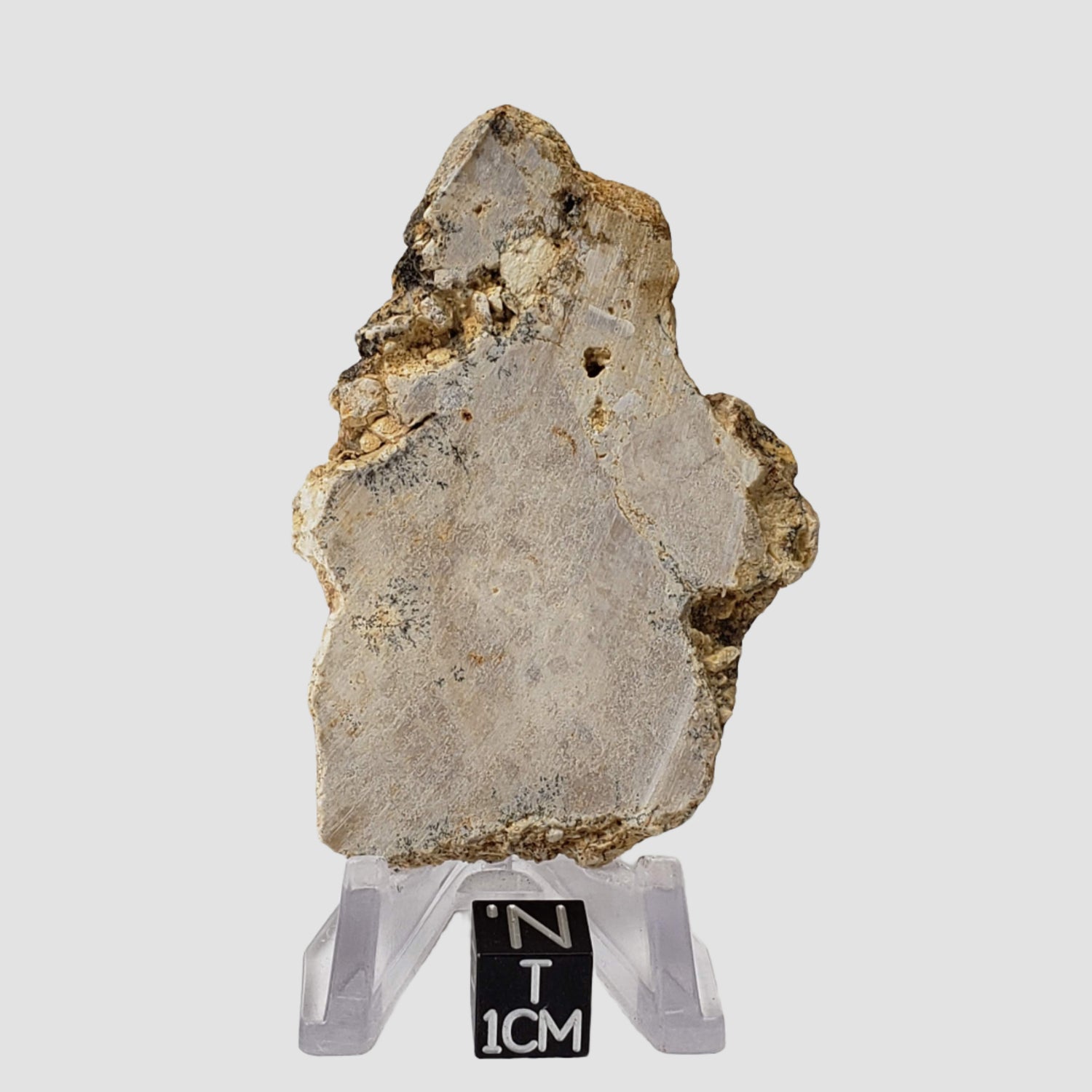
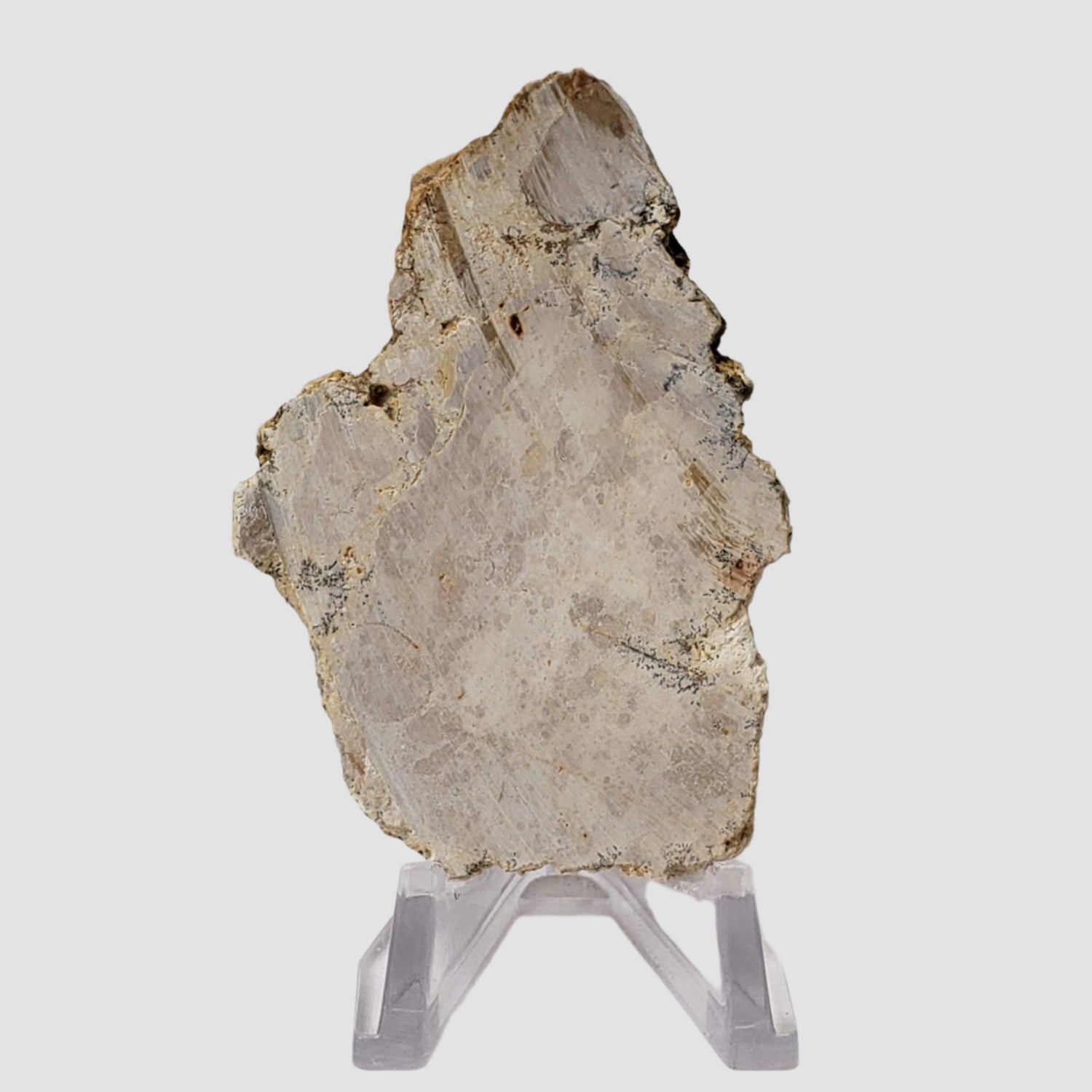
Impactite Fallback Breccia | Steinheim Basin Impact Structure | 32.9 grams | Slice | Ries, Germany
$20.00 CAD
Unit price perImpactite Fallback Breccia | Steinheim Basin Impact Structure | 32.9 grams | Slice | Ries, Germany
$20.00 CAD
Unit price perThis is a fantastic Impactite Fallback Breccia from Germany weighing 32.9 grams and measuring 70x48x7mm. Although not a meteorite, impactites and shatter cones are directly linked to them and their impacts. The Steinheim Basin today exhibits a distinct morphological depression that is ∼110 m deep and ∼3.5 km in diameter; the height of the central uplift totals to more than 140 m. The original size of the pristine crater is estimated to be ∼3.8 km with an original depth of ∼205 m.
As this drainless morphological depression was filled by lake sediments shortly after the impact, the primary crater morphology is widely preserved. The crater rim is formed by steeply inclined and intensely brecciated Upper Jurassic limestone blocks that also contain numerous shattered chert nodules, as well as some loose blocks of the host limestone. An impact breccia, referred to as the so-called ”Primäre Beckenbrekzie” (“primary basin breccia”) and interpreted as a “fallback breccia”, is known from many drillings in the Steinheim Basin.
Mainly composed of Middle to Upper Jurassic limestones, marls, mudstones, and sandstones, the impact breccia inside the morphological depression of the Steinheim Basin is overlain by lake sediments and is obviously preserved in its original thickness and position. This piece displays very well and is a very nice size showing multiple characteristics of its origin. Would make a beautiful addition to any collection.


Impactite Fallback Breccia | Steinheim Basin Impact Structure | 52 grams | Slice | Ries, Germany
$29.00 CAD
Unit price perImpactite Fallback Breccia | Steinheim Basin Impact Structure | 52 grams | Slice | Ries, Germany
$29.00 CAD
Unit price perThis is a fantastic Impactite Fallback Breccia from Germany weighing 52 grams and measuring 69x51x10mm. Although not a meteorite, impactites and shatter cones are directly linked to them and their impacts. The Steinheim Basin today exhibits a distinct morphological depression that is ∼110 m deep and ∼3.5 km in diameter; the height of the central uplift totals to more than 140 m. The original size of the pristine crater is estimated to be ∼3.8 km with an original depth of ∼205 m.
As this drainless morphological depression was filled by lake sediments shortly after the impact, the primary crater morphology is widely preserved. The crater rim is formed by steeply inclined and intensely brecciated Upper Jurassic limestone blocks that also contain numerous shattered chert nodules, as well as some loose blocks of the host limestone. An impact breccia, referred to as the so-called ”Primäre Beckenbrekzie” (“primary basin breccia”) and interpreted as a “fallback breccia”, is known from many drillings in the Steinheim Basin.
Mainly composed of Middle to Upper Jurassic limestones, marls, mudstones, and sandstones, the impact breccia inside the morphological depression of the Steinheim Basin is overlain by lake sediments and is obviously preserved in its original thickness and position. This piece displays very well and is a very nice size showing multiple characteristics of its origin. Would make a beautiful addition to any collection.


Impactite Fallback Breccia | Steinheim Basin Impact Structure | 67.3 grams | Slice | Ries, Germany
$37.00 CAD
Unit price perImpactite Fallback Breccia | Steinheim Basin Impact Structure | 67.3 grams | Slice | Ries, Germany
$37.00 CAD
Unit price perThis is a fantastic Impactite Fallback Breccia from Germany weighing 67.3 grams and measuring 75x59x10mm. Although not a meteorite, impactites and shatter cones are directly linked to them and their impacts. The Steinheim Basin today exhibits a distinct morphological depression that is ∼110 m deep and ∼3.5 km in diameter; the height of the central uplift totals to more than 140 m. The original size of the pristine crater is estimated to be ∼3.8 km with an original depth of ∼205 m.
As this drainless morphological depression was filled by lake sediments shortly after the impact, the primary crater morphology is widely preserved. The crater rim is formed by steeply inclined and intensely brecciated Upper Jurassic limestone blocks that also contain numerous shattered chert nodules, as well as some loose blocks of the host limestone. An impact breccia, referred to as the so-called ”Primäre Beckenbrekzie” (“primary basin breccia”) and interpreted as a “fallback breccia”, is known from many drillings in the Steinheim Basin.
Mainly composed of Middle to Upper Jurassic limestones, marls, mudstones, and sandstones, the impact breccia inside the morphological depression of the Steinheim Basin is overlain by lake sediments and is obviously preserved in its original thickness and position. This piece displays very well and is a very nice size showing multiple characteristics of its origin. Would make a beautiful addition to any collection.


Impactite Fallback Breccia | Steinheim Basin Impact Structure | 16 grams | Slice | Ries, Germany
$11.00 CAD
Unit price perImpactite Fallback Breccia | Steinheim Basin Impact Structure | 16 grams | Slice | Ries, Germany
$11.00 CAD
Unit price perThis is a fantastic Impactite Fallback Breccia from Germany weighing 16 grams and measuring 48x37x7mm. Although not a meteorite, impactites and shatter cones are directly linked to them and their impacts. The Steinheim Basin today exhibits a distinct morphological depression that is ∼110 m deep and ∼3.5 km in diameter; the height of the central uplift totals to more than 140 m. The original size of the pristine crater is estimated to be ∼3.8 km with an original depth of ∼205 m.
As this drainless morphological depression was filled by lake sediments shortly after the impact, the primary crater morphology is widely preserved. The crater rim is formed by steeply inclined and intensely brecciated Upper Jurassic limestone blocks that also contain numerous shattered chert nodules, as well as some loose blocks of the host limestone. An impact breccia, referred to as the so-called ”Primäre Beckenbrekzie” (“primary basin breccia”) and interpreted as a “fallback breccia”, is known from many drillings in the Steinheim Basin.
Mainly composed of Middle to Upper Jurassic limestones, marls, mudstones, and sandstones, the impact breccia inside the morphological depression of the Steinheim Basin is overlain by lake sediments and is obviously preserved in its original thickness and position. This piece displays very well and is a very nice size showing multiple characteristics of its origin. Would make a beautiful addition to any collection.
This is a great 43.6 gram Impact Melt Breccia from the Gardnos Crater in Norway. It is amazingly light considering its mass of 54x43x9mm. Although not a meteorite, impactites are directly linked to them and their impacts and are probably going to be one of the rarest collection item you'll ever own. Impactite is a slag-like glassy object found on the surface of the earth, formed from rock melted by the impact of a meteorite.
The term impactite encompasses shock-metamorphosed target rocks, melts or suevites and mixtures of the two, as well as sedimentary rocks with significant impact-derived components and shocked mineral grains, tektites, anomalous geochemical signatures, etc.
This impactite was formed between 385 and 900 million years ago in Precambrian time when a meteorite crashed into the earth making a ~5 kilometers wide crater locally known as the Hallingdal Impact Crater.
Would be a beautiful addition to any new or existing collection. Comes with a Canagem Collection specimen card.
This is a great 22 gram Impact Melt Breccia from the Gardnos Crater in Norway. It is amazingly light considering its mass of 56x28x9mm. Although not a meteorite, impactites are directly linked to them and their impacts and are probably going to be one of the rarest collection item you'll ever own. Impactite is a slag-like glassy object found on the surface of the earth, formed from rock melted by the impact of a meteorite.
The term impactite encompasses shock-metamorphosed target rocks, melts or suevites and mixtures of the two, as well as sedimentary rocks with significant impact-derived components and shocked mineral grains, tektites, anomalous geochemical signatures, etc.
This impactite was formed between 385 and 900 million years ago in Precambrian time when a meteorite crashed into the earth making a ~5 kilometers wide crater locally known as the Hallingdal Impact Crater.
Would be a beautiful addition to any new or existing collection. Comes with a Canagem Collection specimen card.
The Azuara polymict impact breccia refers to the impact material from the 38 million year old twin (multiple) impact structures Azuara / Rubielos de la Cerida in Northern Spain.
This polymict impact breccia was found in the area of Santa Cruz de Nogueras near the center area of this large multiple impact structure. This is partly melted and/or decarbonized limestone fragments in a dense and extremely hard matrix showing flow texture. The breccia is considered an equivalent to suevite impactites in other impact structures. This beautiful slice has dimensions of 110x51x11 mm and weighs 122 grams.
Would be a beautiful addition to any new or existing collection. Comes with a Canagem Collection specimen card.
The Azuara polymict impact breccia refers to the impact material from the 38 million year old twin (multiple) impact structures Azuara / Rubielos de la Cerida in Northern Spain.
This impact breccia was found in the area of the village of Fuendetodos near the center area of this large multiple impact structure. This is partly melted and/or decarbonized limestone fragments in a dense and extremely hard matrix showing flow texture. The breccia is considered an equivalent to suevite impactites in other impact structures. This beautiful slice has dimensions of 115x63x13 mm and weighs 156 grams.
Would be a beautiful addition to any new or existing collection. Comes with a Canagem Collection specimen card.
The Azuara polymict impact breccia refers to the impact material from the 38 million year old twin (multiple) impact structures Azuara / Rubielos de la Cerida in Northern Spain.
This impact breccia was found in the area of the village of Fuendetodos near the center area of this large multiple impact structure. This is partly melted and/or decarbonized limestone fragments in a dense and extremely hard matrix showing flow texture. The breccia is considered an equivalent to suevite impactites in other impact structures. This beautiful slice has dimensions of 117x79x9 mm and weighs 163 grams.
Would be a beautiful addition to any new or existing collection. Comes with a Canagem Collection specimen card.


Black Onaping | 217 Grams | Impactite Breccia Slice | Sudbury Structure, Canada
$342.00 CAD
Unit price perBlack Onaping | 217 Grams | Impactite Breccia Slice | Sudbury Structure, Canada
$342.00 CAD
Unit price perThis is a must have 217.7 gram slice of Black Onaping Impact Fallback Breccia from the famous Sudbury Impact Structure in Ontario Canada. It's dimensions are 126x117x7 mm. Although not a meteorite, impactites are directly linked to them and their impacts and are probably going to be one of the rarest collection piece you'll ever own.
About 1.87 billion years ago, an object from space 9 kilometers in diameter, slammed into Canada a little north of Sudbury, Ontario creating the second largest impact structure on the earth. This impact was equivalent to a billion tons of TNT; an impact so great that it cracked the earth, in fact they still have earthquakes because of it today!
This specimen of Sudbury Black Onaping Breccia is a lithified fallback breccia composed of melt glass and country target rock fragments. This meteorite impact created a large mushroom cloud that fell back down to earth to create this breccia. "Bucky Ball Fullerine" with terrestrial carbon in the form of C-60 and C-70 is found in this type of Sudbury impact rock. Greenish-Blueish dust covered Tektites can also be found within its matrix. The Onaping forms in two layers, the first one is grey and second one is black.
The many mineral rich deposits and strange rock formations in such close proximity has attracted attention for 100's of years, long before its impact origin was known. Thomas Edison, for instance, built a lab on site and NASA Moonwalker "Gene" Cernan, who studied and collected geology samples as part of his pre-moon mission training.
Would be a beautiful addition to any new or existing collection. Comes with a Canagem Collection specimen card.


Black Onaping | 191 Grams | Impactite Breccia Slice | Sudbury Structure, Canada
$302.00 CAD
Unit price perBlack Onaping | 191 Grams | Impactite Breccia Slice | Sudbury Structure, Canada
$302.00 CAD
Unit price perThis is a must have 191.39 gram slice of Black Onaping Impact Fallback Breccia from the famous Sudbury Impact Structure in Ontario Canada. It's dimensions are 116x115x6 mm. Although not a meteorite, impactites are directly linked to them and their impacts and are probably going to be one of the rarest collection piece you'll ever own.
About 1.87 billion years ago, an object from space 9 kilometers in diameter, slammed into Canada a little north of Sudbury, Ontario creating the second largest impact structure on the earth. This impact was equivalent to a billion tons of TNT; an impact so great that it cracked the earth, in fact they still have earthquakes because of it today!
This specimen of Sudbury Black Onaping Breccia is a lithified fallback breccia composed of melt glass and country target rock fragments. This meteorite impact created a large mushroom cloud that fell back down to earth to create this breccia. "Bucky Ball Fullerine" with terrestrial carbon in the form of C-60 and C-70 is found in this type of Sudbury impact rock. Greenish-Blueish dust covered Tektites can also be found within its matrix. The Onaping forms in two layers, the first one is grey and second one is black.
The many mineral rich deposits and strange rock formations in such close proximity has attracted attention for 100's of years, long before its impact origin was known. Thomas Edison, for instance, built a lab on site and NASA Moonwalker "Gene" Cernan, who studied and collected geology samples as part of his pre-moon mission training.
Would be a beautiful addition to any new or existing collection. Comes with a Canagem Collection specimen card.

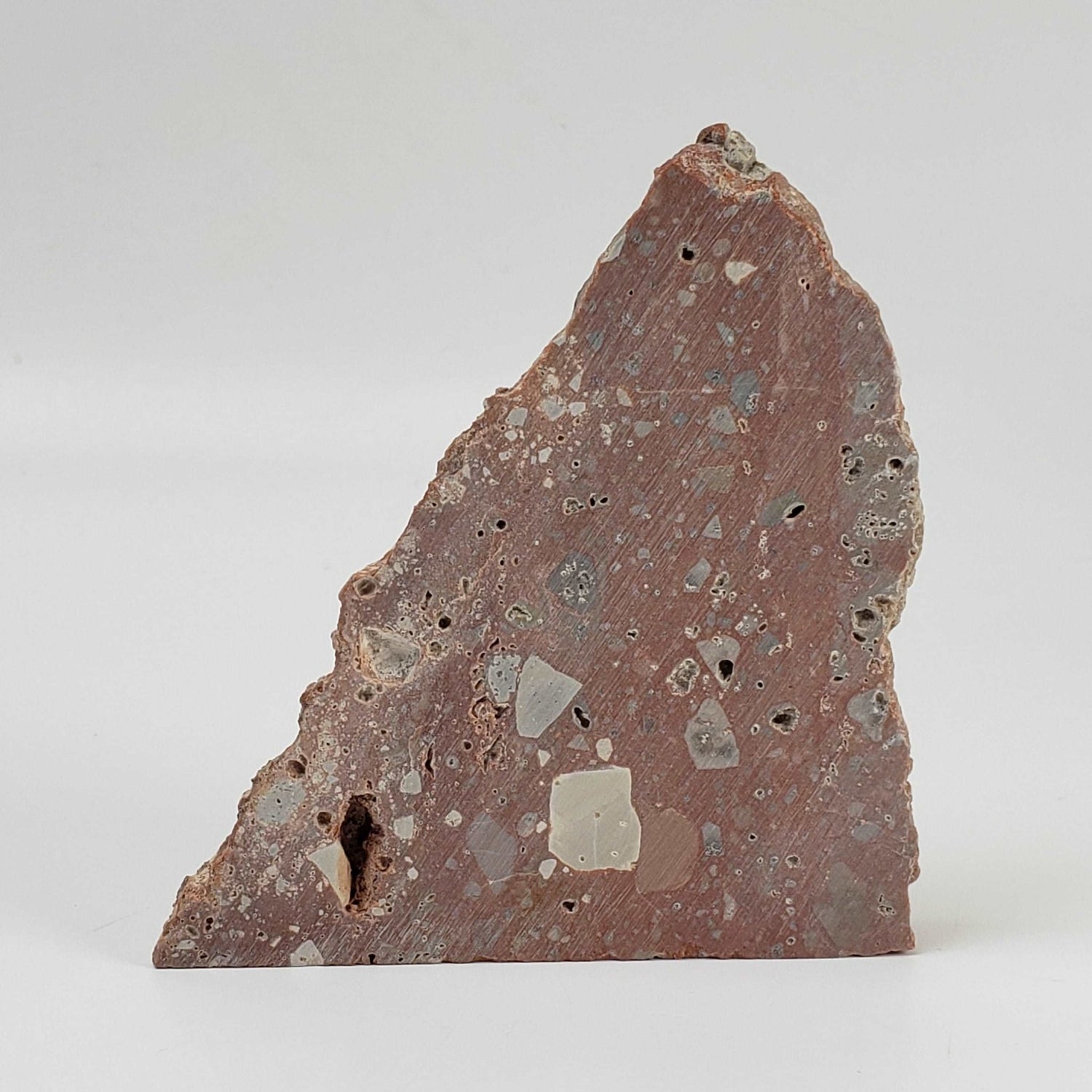
Azuara Basal Breccia | 110 Grams | Rubielos de la Cerida Impact Structure, Spain
$104.00 CAD
Unit price perAzuara Basal Breccia | 110 Grams | Rubielos de la Cerida Impact Structure, Spain
$104.00 CAD
Unit price perThe Azuara Basal breccia refers to the impact material from the 38 million year old twin (multiple) impact structures Azuara / Rubielos de la Cerida in Northern Spain,.
This impact breccia was found on the southwestern central-uplift chain between Villarquemado and Celadas. This amazing specimen displays sharp edged rock fragments imbedded in a matrix of pulverized rocks. This beautiful and colorful slice has dimensions of 87x81x11 mm and weighs 110 grams.
Would be a beautiful addition to any new or existing collection. Comes with a Canagem Collection specimen card.
This is a must have 209 gram polymict impact breccia from the Lockne Crater located approximately 21 km south of the city of Östersund in northern Sweden. It is amazingly light considering its mass of 132x63x23 mm. Although not a meteorite, impactites are directly linked to them and their impacts and are probably going to be one of the rarest collection items you'll ever own. Impactite is a slag-like glassy object found on the surface of the earth, formed from rock melted by the impact of a meteorite.
The term impactite encompasses shock-metamorphosed target rocks, melts or suevites and mixtures of the two, as well as sedimentary rocks with significant impact-derived components and shocked mineral grains, tektites, anomalous geochemical signatures, etc.
Lockne is a 7.5km-wide impact structure that formed circa 455 Ma when an L-chondritic asteroid impacted mixed sedimentary and crystalline target rocks that were under a shallow epicontinental sea (500m deep) at the time. The feature and its surrounding impactite deposits were covered by Caledonian thrust nappes that also partly folded them.
Erosion has breached much of the overthrust rocks to show the impact site. Impactites include the Loftarstone (graywacke-like arenite with carbonate grains), Lockne Breccia (polymictic but mostly limestone clasts), Resurge deposits, Ynntjämen Breccia (monomictic, matrix-supported with calcareous-argillaceous matrix) and the Tandsbyn Breccia (monomictic crystalline ejecta). This crater has been suggested to be a doublet with the nearby smaller Målingen Crater, 16 km apart.
This gorgeous large slice displays very well. It would be a beautiful addition to any new or existing collection. Comes with a Canagem Collection specimen card.


Impact Breccia Part Slice | 59.5 Grams | Metal Rich Impactite | Sudbury Structure, Canada,
$103.00 CAD
Unit price perImpact Breccia Part Slice | 59.5 Grams | Metal Rich Impactite | Sudbury Structure, Canada,
$103.00 CAD
Unit price perThis is a must have 59.5 gram Metal Ore Copper rich Impact Breccia from the famous Sudbury Astrobleme Impact Structure in Ontario Canada. Its dimensions are 52x31x13 mm. Although not a meteorite, impactites are directly linked to them and their impacts and are probably going to be one of the rarest collection pieces you'll ever own.
Mark Bostick wrote "About 1.87 billion years ago, an object from space nine kilometers in diameter slammed into Canada, a little north of Sudbury, Ontario creating the second largest impact structure on the earth. This impact was equivalent to a billion tons of TNT. An impact so big it cracked the earth, and in fact there are still earthquakes because of that event today! The many mineral rich deposits and strange rock formations in such close proximity has attracted attention for 100's of years, long before its impact origin was known.
Note that this is not a meteorite but a slice of Earth rock, altered by the impact of a very large meteorite. This came from the ring of the impact and is the harder to find gold-copper-bronze colored impactite described as a metal-rich breccia and sulfides composed chiefly of some amount of iridium, cobalt & selenium. In addition, most of these specimens will contain nickel, iron, sperrylite and pentlandite as well as minor amounts of other metals, metallic & silicate minerals."
Note that this is a very fragile material so it will be packed with attention. Would be a beautiful addition to any new or existing collection. Comes with a copy of a signed Mark Bostick Collection and a Canagem Collection specimen card.

